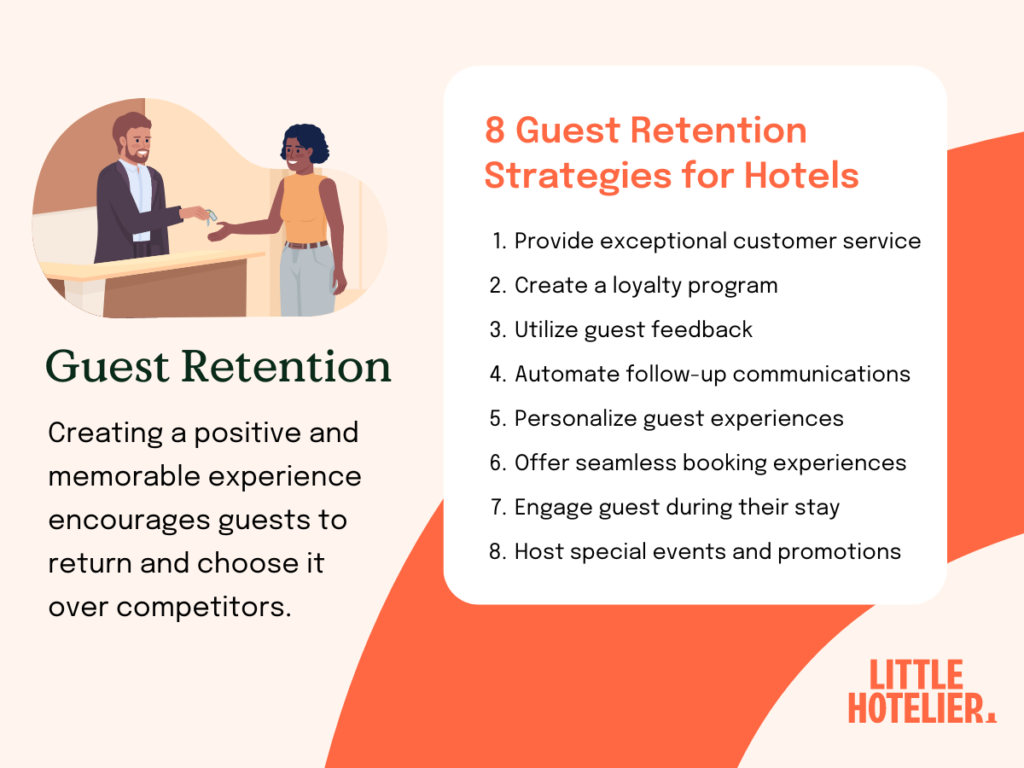What is guest retention?
Guest retention refers to the strategies and efforts that encourage guests to return to your property after their first stay. It’s about building lasting relationships through personalised experiences, loyalty programs, and consistent engagement.
Understanding the concept of guest retention in hospitality
In the hospitality industry, guest retention is the foundation of long-term profitability. Small properties, like B&Bs and boutique hotels, thrive on repeat business. Retaining a guest costs less than acquiring a new one and often leads to higher spending per stay.
Engaging with guests post-stay through follow-ups, special offers, or simply ensuring they feel valued helps transform a one-time visitor into a loyal guest. This strong connection also promotes direct bookings, reducing the need for OTAs (online travel agencies) and saving on commission fees.
Earn and keep more loyal guests with Little Hotelier
Maximise guest retention with Little Hotelier’s easy-to-use platform. Simplify your guest engagement and boost repeat bookings.
Learn moreWhy is hotel guest retention important for small properties?
For small hotels, building loyalty among guests creates a steady, reliable flow of bookings, even during off-peak seasons. It’s particularly valuable when larger competitors rely heavily on mass marketing and OTA bookings, making it harder for smaller properties to attract first-time guests.
By focusing on retention, small hotels like yours can develop a loyal customer base that chooses to return due to positive experiences, personal touches, and special incentives.
Hotel guest acquisition cost vs guest retention
The cost of acquiring a new guest is substantially higher than retaining an existing one. Between marketing campaigns, OTA commissions, and promotional offers, guest acquisition can eat into your profit margins. In contrast, retention strategies are more cost-effective – repeat guests are more likely to book directly, and you don’t have to spend as much on marketing to re-engage them.
- Acquisition costs: These include advertising fees, OTA commissions, and introductory discounts, which can be as high as 20% of the booking value.
- Retention costs: Often include loyalty rewards, email marketing campaigns, and small perks like room upgrades, which are far more affordable.

Key steps of the guest retention process
Understanding how to implement guest retention strategies can significantly improve loyalty and drive business growth. Here are the essential steps to follow:
Step 1: Deliver outstanding service
Excellent service during a guest’s stay is the foundation of retention. Personalise their experience wherever possible by remembering their preferences and ensuring their stay is smooth.
Step 2: Follow up post-stay
Send a personalised thank-you email after checkout. This small gesture makes guests feel appreciated and opens the door for future communication, whether through offers or feedback requests.
Step 3: Offer loyalty programs
Create a simple loyalty program that rewards repeat stays with discounts, upgrades, or free services. Even a small incentive can make a big difference in encouraging return visits.
Step 4: Collect and utilise feedback
Ask guests for feedback after their stay and implement any necessary improvements. Showing that you value their input and are actively working to improve creates trust and satisfaction.
Step 5: Stay engaged
Consistent communication through email newsletters or exclusive offers keeps your property top of mind. However, ensure the messages are personalised and relevant to the guest’s preferences.
What is the difference between guest retention and acquisition?
While both guest retention and acquisition are essential for a hotel’s success, they serve different purposes and have distinct impacts on your business.
| Aspect | Guest Retention | Guest Acquisition |
| Impact | Builds long-term relationships, fostering loyalty and repeat business, leading to sustainable growth. | Drives short-term revenue by filling rooms with new guests but benefits may be fleeting without retention efforts. |
| Key Focus | Personalised experiences that ensure guests return. Small hotels excel by offering tailored services and unique touches. | Targets new guests through marketing campaigns, OTAs, or special offers, yielding quicker but costlier results. |
| Challenges | Requires consistent personalisation, excellent service, and ongoing engagement, which can be time-consuming. | High marketing costs and competition, especially from larger properties with more resources. |
| Strategies | Loyalty programs, post-stay follow-ups, personalised communication, and leveraging reviews and referrals. | OTAs, digital marketing, and seasonal promotions to attract new guests during low-demand periods. |
| Metrics | Measured by guest lifetime value (LTV) and repeat bookings. | Measured by customer acquisition cost (CAC) and occupancy rates. |
| Customer Base Growth | Solidifies the core guest base by turning one-time guests into loyal customers. | Expands the customer base by bringing in new guests, but risks high churn without retention efforts. |
| Revenue Growth | Drives steady, long-term revenue as loyal guests tend to spend more and book more frequently. | Can create spikes in revenue, especially during peak seasons or promotional periods. |
| Profitability | More profitable by reducing reliance on OTAs and other costly acquisition channels. | More expensive but necessary. Combining acquisition with efforts to convert first-time guests can improve profits. |
| Best Practices | Encourage direct bookings, nurture guest loyalty with post-stay engagement and personalised offers, and promote reviews. | Use OTAs for exposure, but offer incentives for direct bookings to reduce reliance on third-party platforms. |
| Examples | A loyalty program offering discounts or free upgrades to encourage repeat visits. | Offering a direct booking discount to first-time OTA guests to convert them into repeat customers. |
Balancing hotel guest retention and acquisition for business growth
Balancing guest retention and acquisition is crucial for long-term growth. Small properties must juggle attracting new guests to fill rooms while retaining loyal customers to ensure consistent occupancy. During off-peak seasons, acquisition efforts like targeted promotions can help fill vacancies, while retention ensures that you maintain steady bookings year-round.
A great way to balance both is by using OTAs to bring in new guests, then turning them into loyal customers through exceptional service and post-stay follow-ups. Promoting direct bookings with special offers is another effective strategy to reduce acquisition costs over time.
By Dean Elphick
Dean is the Senior Content Marketing Specialist of Little Hotelier, the all-in-one software solution purpose-built to make the lives of small accommodation providers easier. Dean has made writing and creating content his passion for the entirety of his professional life, which includes more than six years at Little Hotelier. Through content, Dean aims to provide education, inspiration, assistance, and, ultimately, value for small accommodation businesses looking to improve the way they run their operations (and live their life).
Table of contents
“The mobile app is a breeze to use and when you need assistance, you can always count on excellent customer service to be there for you.”
Managing Director, Smans Villas









Meg Hollins,
Marketing & Events Manager
Holbrook Hotel